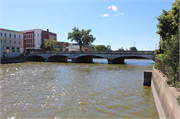Property Record
MILWAUKEE STREET OVER ROCK RIVER
Architecture and History Inventory
| Historic Name: | Milwaukee Street Bridge (P-53-715) |
|---|---|
| Other Name: | |
| Contributing: | |
| Reference Number: | 230814 |
| Location (Address): | MILWAUKEE STREET OVER ROCK RIVER |
|---|---|
| County: | Rock |
| City: | Janesville |
| Township/Village: | |
| Unincorporated Community: | |
| Town: | |
| Range: | |
| Direction: | |
| Section: | |
| Quarter Section: | |
| Quarter/Quarter Section: |
| Year Built: | 1913 |
|---|---|
| Additions: | |
| Survey Date: | 2016 |
| Historic Use: | bridge |
| Architectural Style: | Neoclassical/Beaux Arts |
| Structural System: | Concrete Arch |
| Wall Material: | Concrete |
| Architect: | C.v. Kerch-designer; Gould Construction Co.-builder |
| Other Buildings On Site: | |
| Demolished?: | No |
| Demolished Date: |
| National/State Register Listing Name: | Not listed |
|---|---|
| National Register Listing Date: | |
| State Register Listing Date: |
| Additional Information: | A 'site file' exists for this property. It contains additional information such as correspondence, newspaper clippings, or historical information. It is a public record and may be viewed in person at the Wisconsin Historical Society, State Historic Preservation Office. The bridge was designed by city engineer C.V. Kerch. Construction was undertaken by Gould Construction Company of Davenport, Iowa in 1913. The spandrel and pier paneling and cast-concrete balustrade railing give the bridge a modest Neo-Classical appearance. The balusters have an urn shape and are aligned tightly in rows between rectangular posts and decorative incised panels. Original plans for the bridge called for light standards on each of the piers. While evidence indicates that lighting was installed on the bridge, they have since been removed. Currently two modern light standards are located on the bridge. The bridge was built to replace an existing structure on roughly the same alignment. The previous timber pile bridge was built in 1867 and destroyed by fire in in April 1913 2016- "The Milwaukee Street Bridge is a four-span, filled-spandrel, reinforced-concrete, continuous arch bridge that carries three travel lanes over the Rock River in the city of Janesville. The overall length of the structure is 226 feet with an overall bridge width of 54 feet (out-to-out of rails), including 2-foot-wide curb and gutter, 7.2-foot-wide sidewalks, and 1.1-foot-wide railings on both sides. The travel lanes rest on fill confined by the arches and vertical fascia walls, and the concrete abutments and piers are supported on timber pile footings. The bridge, which was designed by city engineer C.V. Kerch, was built to replace an existing structure on roughly the same alignment. The previous timber pile bridge built in 1867 was destroyed by fire in April 1913. Construction of the new bridge was undertaken by Gould Construction Company of Davenport, Iowa, in 1913. The spandrel and pier paneling and cast-concrete balustrade railing give the bridge a modest Neo-Classical appearance. The balusters have an urn shape and are aligned tightly in rows between rectangular posts, end rail panels, and decorative incised panels. Original plans for the bridge called for light standards on each of the piers and east abutment. According to an article in Cement Engineering News (CEN), cluster light standards were mounted on baluster posts over each pier and abutment. However, a c.1919 photograph of the bridge shows single luminary standards situated on baluster posts over each pier and abutment. At some point they were removed. Currently, two modern light standards are located on the bridge, one each on the north and south sides. At the time it was constructed, the bridge carried a 35-foot-wide roadway with concrete gutters and an 8-foot-wide sidewalk on both sides. It also featured a gas main, electric, and telephone conduits under the sidewalks. The bridge was designed to carry a 60-ton interurban streetcar line. Streetcar service ceased operating in 1929. The wrought-iron pipe trolley poles and wiring associated with the streetcar line have been removed and the roadway was presumably reconstructed shortly thereafter. The existing concrete balustrade railings are in poor condition. Much of the balustrade railing is cracked and/or broken, and in some areas the rebar is partially to fully exposed. In 2012 a traffic accident resulted in the destruction of a section of the balustrade on the south elevation. Impacts include the complete loss of one section of urn-shaped balusters, damage to individual balusters and concrete posts, and a bow in the balustrade alignment. Temporary concrete traffic barriers were added along this portion of the bridge to act as a barricade for safety reasons. The current structure has undergone a number of alterations since its construction. By 1986 changes to the approaches, including the addition of staircases leading to the recently constructed Ice Age Trail system on the west bank and a non-motorized path on east bank of the bridge, resulted in the removal of a portion of the balustrade and end rail panels at three of the four quadrants of the bridge (only the northwest panel is extant), leaving the much narrower concrete posts to serve as end panels. At some point prior to the mid-1980s a skim coat of concrete was applied to portions the structure. Additionally, wingwalls included in the original plans are no longer visible due to the addition of river walls that were constructed in-line with the abutments prior to the 1980s. According to an independent engineering study report prepared by Bloom Companies, LLC, it is unclear whether the wingwalls were removed when the river walls were added." -"Milwaukee Street Bridge (P-53-715), Prepared by Mead & Hunt, Inc., (2016). |
|---|---|
| Bibliographic References: |
| Wisconsin Architecture and History Inventory, State Historic Preservation Office, Wisconsin Historical Society, Madison, Wisconsin |





